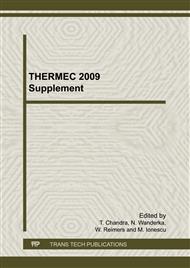p.41
p.47
p.53
p.59
p.65
p.73
p.79
p.85
p.91
Synthesis and Characterization of Cu and Ni Bearing Nano-Composites and Nano-Structured Alloys
Abstract:
It is well recognized the importance of nano-structured materials in the present technological stage. Due to their unique properties these materials can be used in a large number of applications. One example is the growing interest in nanocomposites, in which a very fine dispersion of a ceramic phase in a metal matrix will significantly improve the material properties. In view of that, extensive studies have been carried out on a variety of materials such as alloys and different types of composites. Recently, the authors have developed a novel chemical method for in-situ formations of Cu-Al2O3 and Ni-Al2O3 nanoscale composites by decomposition of their mixed nitrate solutions, to co-form the nano oxides, followed by preferential reduction of CuO or NiO by hydrogen at very low temperature. Studies carried out by the authors on the kinetics of reduction of such fine oxides indicated that under low partial pressure of hydrogen (0.25 atm) in argon, the oxides of Ni and Cu can be reduced completely, in a low temperature range of 523 to 623 K. The composites containing nanosized metal-metal oxide particles have been found to be quite homogeneous in nature. In view of this, Cu-Ni and Ni-Co alloys was also produced by mixing the respective aqueous nitrate solutions, followed by decompositions of their nitrates to their mixed oxides and subsequent low temperature hydrogen reduction. In that context, the purpose of the present work is to address the fundamental aspects of the synthesis procedure, emphasizing the basic thermodynamics background of the two steps involved. Also, the work aims to illustrate the outcome, by presenting experimental conditions and providing relevant characterization of the obtained nano-materials, by means of electronic microscopy and X-Ray Diffraction. Examples are given in terms of the obtained nano-composites and alloys.
Info:
Periodical:
Pages:
65-72
Citation:
Online since:
January 2010
Authors:
Keywords:
Price:
Сopyright:
© 2010 Trans Tech Publications Ltd. All Rights Reserved
Share:
Citation:


